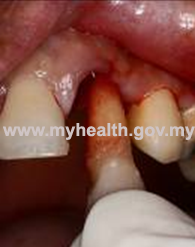A third of preschool children have sustained injuries to the dental tissues and its supporting structures. Amongst school children, 25% have experienced dental injuries. In adults, 25 % are reported to have had dental injuries (Glendor 2008).
The causes of dental injuries
Young children who are just learning to walk, run, climb or ride a bike, have a tendency to fall. Injuries in the oral region could also occur if the child has a fall when he has objects such as spoons or pencils in the mouth.
When should I take my child to the dentist?
- If your child exhibits these signs, he needs to be taken to the Emergency Department or to a dental clinic.
- There is continuous bleeding for 10 to 15 minutes
- The child has a toothache, or tooth sensitivity following the injury
- The teeth are broken, loose or knocked out ( Fig. 1 ). Ideally, the tooth if it’s permanent should be put back into its socket immediately. If this is not possible, then the tooth should be put into fresh milk . This is a dental emergency and the child should be taken to a dental clinic / emergency department.

( Fig. 1)
- The tooth that has been knocked out cannot be found
- The child has difficulty breathing or swallowing.
- There is an object lodged within the oral tissues. Do not try to remove this yourself.
- Pain on mouth opening or closure.
- Inability to open / close the mouth as usual.
- The injuries in the mouth continue over the lips to the facial skin.
- The child experiences numbness, weakness, blurred vision or slurred speech.
- There are signs of infection, such as swelling, pain, difficulty in opening his mouth, redness or pus discharge.
- There are concerns about the child’s condition.
Treatment
The treatment would differ depending on whether the affected tooth is a baby tooth or a permanent tooth.
Injury to the primary tooth could also affect the developing permanent tooth within the jaw. Hence, parents are advised to monitor the development of their child’s permanent teeth. The anterior teeth erupt around the ages of 6-8. If the teeth do not erupt, then the child needs to be assessed by a dentist.
How do I determine if it is a permanent tooth or a baby tooth?
Usually the front teeth erupt around the ages 6 to 8. If unsure, then bring the child along to the dentist. If it is uncertain whether a tooth that has been knocked out is a permanent or baby tooth, then place it in cold milk and bring it along to the dentist as a matter of urgency. (This is because if it is a permanent tooth, then it needs to be repositioned as soon as possible for the best outcome).
What are the potential complications following a dental injury?
In most cases, a child would have good post –trauma healing. Prompt dental attention would ensure better chances of a good outcome.
On occasion, some complications may occur. The child would need to see a dentist if:
- There is an infection around the injured tooth
- The injured tooth changes colour
- The development of permanent tooth is delayed
- There is excessive bleeding
- A tooth that has been knocked out is accidentally inhaled or swallowed. It is a medical emergency if the child has breathing difficulties.
What can be done to stop the bleeding from a minor oral injury?
Sometimes a child may also sustain injuries to the soft tissues in the mouth. This can sometimes bleed quite a lot.
Steps to reduce excessive bleeding
If there is an injury to the inner lip or cheek, then a clean towel can be used to apply pressure from the outer lip or cheek. Constant pressure for about 10 -15 minutes should stop the bleeding. For a tongue wound, a clean towel or gauze can be placed over the injury and get the child to press the tongue against the mouth to stop the bleeding.
Encourage the child to swallow his saliva. He should not rinse as this would delay the formation of a blood clot.
The child will need to be taken to a dentist if the bleeding does not stop, or if it is a large wound.
A large wound may need to be cleaned and sutured by a dentist. Local analgesia can be given as pain relief.
A small wound would heal in 3-4 days. When it is healing, the tissues may turn pale or white initially.
Pain control
If the child is in pain, he can be given some painkillers as appropriate for his age.
Oral hygiene after a dental injury
It is important that good oral hygiene is maintained after an injury. The child should brush his teeth as usual twice daily. Sometimes, the dentist may prescribe a mouthwash to aid in keeping the mouth clean.
Tetanus Prevention
If required, your dentist would refer your child to a medical doctor for a tetanus booster dose.
Prevention of dental injuries
The impact of an injury to the teeth can be reduced with the use of a mouthguard [hyperlink to mouthguard article]. Children with very proclined upper incisors have a higher risk of sustaining dental injuries.
The use of mouthguards is recommended when partaking in contact sports such as football, boxing, hockey etc.
References
- Andreasen JO, Borum MK, Jacobsen HL, Andreasen FM. Replantation of 400 avulsed permanent incisors. 4. Factors related to periodontal ligament healing. Endod Dent Traumatol 1995; 11:76.
- U Glendor, Epidemiology of traumatic dental injuries – a 12 year review of the literature. Dental Traumatology 2008; 24:603-611
| Last Reviewed | : | 24 January 2014 |
| Writer | : | Dr. Yogeswari a/p Sivapragasam |







